
 Dear Members:
Dear Members:
Call me boring. Every morning, seven days a week, 52 weeks a year, I have hot cereal (yes, even in the summer) with strawberries, blueberries, and soy milk. Don’t knock soy milk until you’ve tried it. I love the taste and it’s very good for you.
My wife, Pauline, does most of the grocery shopping, and her favorite store for produce is Whole Foods. Their fruits and veggies—including my strawberries and blueberries—cost somewhat more than those from other supermarket chains, but customers seem to think the produce is worth the higher price. We have found their produce generally tastes better than that from lower cost grocery chains, and the yield, after cutting-up and removing overripe or inedible parts, is almost always much higher. It’s entirely possible that the overall cost for higher quality produce is comparable to the lower (initial) cost alternative.
Different story: In the early 1990s, I consulted to a firm that was interested in purchasing a chicken processing/packaging company in Massachusetts. This successful company specialized in selling low-cost chicken parts to stores that catered to low-income families. Their retail chicken-part prices were always well below those in most recognizable grocery chains. When visiting the company I was disturbed to discover that part of the “processing” was to soak the chicken parts in an aqueous (water) solution which added weight to the final product (This apparently was perfectly legal). So, the low-income families were certainly paying less per pound for a package of chicken parts, but part of the weight they were paying for was water. I recommended against the purchase of this company.
What do these two stories have to do with the BOB and proton therapy?
In this month’s BOB Tales, you will read about an important paper published in the Journal of Comparative Effectiveness Research, comparing proton therapy to IMRT for treating two tumor sites. The authors acknowledge that there is much controversy about the higher initial cost of leading-edge technologies, such as proton therapy, but focusing on initial cost alone can be seriously misleading. By using a sophisticated analysis technique that looks at overall, long-term cost and patient experience, there was a startling revelation:
In these studies, not only was proton therapy less costly over time, but there were also improved results in patients’ quality of life.
We have been postulating this for years based on our own personal experience as well as anecdotal information from surveys and member feedback. And, while the two tumor sites studied did not include the prostate, much of what the paper concludes should apply to all tumor sites treated with protons, including the prostate. This is a landmark paper in my opinion; one that may be helpful to those fighting insurance denials in the future.
Bottom line: Focusing on initial cost only can be short-sighted and can lead to bad decisions in the grocery store, in health care, and in life.
In addition to a review of this important paper, this month’s BOB Tales includes information about new directions for proton therapy, another recent event that may favorably impact reimbursement for proton therapy, and several valuable health tips for members.
Finally, my wife, Pauline, daughter, Deb, and I are excited about attending the 25th proton center anniversary event at Loma Linda University Health in late October. We plan to be there from Saturday, October 24 to Wednesday, October 28 and hope to connect with many current and former patients along with our Loma Linda University Health “family.” We have attended several anniversary celebrations in the past and they have all been well-attended and memorable occasions.
I hope you enjoy this month's BOB Tales. As always, we welcome your feedback and suggestions for future newsletters. Just send an email to [email protected].
Bob Marckini
To print the BOB Tales newsletter or view the newsletter with a larger font size, click here for the PDF file.
Membership:
We have more than 8,000 members from all U.S. states and 39 countries. Members represent all operating proton centers in the U.S. as well as four proton centers in Europe and Asia.
In This Issue:
- Three trends in proton therapy
- Important paper puts proton therapy into proper light
- Important news on diet and prostate cancer
- President Jimmy Carter could benefit from proton therapy
- Judge tells Aetna to pay for proton therapy
- Meet Bob and Deb in Loma Linda next month!
- BOB member turns 102
- Snacks that increase your energy
- Belly fat—serious problem for older men
- Foods that help fight belly fat
.jpg)
Three Trends in Proton Therapy
The following commentary on proton therapy trends was provided to us by John Frick, Interim Executive Director of NAPT (The National Association for Proton Therapy).

- Obtaining Insurance Coverage Becoming More Difficult: Obtaining insurance coverage for proton therapy on a timely basis has never been good and is becoming more difficult. This challenge could increase as major insurance companies merge and local hospital systems consolidate. Despite these changes, patients who work closely with their radiation oncologists and proton therapy center often, but not always, obtain the coverage they deserve. Fighting the insurance company strategy of “denial by delay” has become an art form. Even when insurance coverage appeals are unsuccessful, they help make it easier for the next patient.
- Proton Patient Mix Evolving: A recent change that has gone largely unnoticed is that the National Association of Proton Therapy survey revealed that the patient mix at proton therapy centers is evolving to more closely mirror the relative incidence of different cancers. Prostate cancer now accounts for fewer than half of the patients at many proton therapy centers even though the absolute number of prostate cancer patients treated with proton therapy is increasing. This is because patients with breast and lung cancer, the two most common cancers, are benefiting from proton therapy. Several less common cancers are also being treated with proton therapy.
- Major Cancer Centers Building Proton Facilities: The biggest recent change in the proton therapy industry is that nearly all of the major cancer centers now have or are building proton therapy centers. There are seventeen proton therapy centers treating patients in the United States and another dozen are under construction and could be treating patients by the end of next year. Contrary to the assertion of some critics, who consider the increase of proton therapy centers evidence of an “arms race” driven by the lure of excess profits, the trend toward adopting proton therapy as the Gold Standard for radiation therapy is also happening in the United Kingdom and China; countries that are never accused of overspending on health care or adopting new technologies prematurely. Despite this progress, it will still be a few years before even 1 percent of U.S. patients who receive radiation therapy receive proton therapy.

BOB Comment: As you can see, far fewer than 1 percent of radiation patients are receiving proton therapy. We BOB members are among the fortunate few who have had access to this revolutionary treatment.
Important Paper Puts Proton Therapy into Proper Light
An important paper was published last month in the Journal of Comparative Effectiveness Research [J.Comp. Eff. Res. (2015) 4(4), 297-301]. The title is “Comparative Costs of Advanced Proton and Photon Radiation Therapies: Lessons From Time-driven Activity-based Costing in Head and Neck Cancer.”
 The paper points out that advanced technology is responsible for driving improvements in cancer care outcomes, but it often comes with steep increases in the cost of cancer care delivery. However, the paper emphasizes, cost-effectiveness analyses of costly therapies have been under emphasized. It is possible, the paper points out, for a medical technology to have a higher initial cost, but a lower overall, longer-term cost. The focus of this paper was radiation oncology in cancer care.
The paper points out that advanced technology is responsible for driving improvements in cancer care outcomes, but it often comes with steep increases in the cost of cancer care delivery. However, the paper emphasizes, cost-effectiveness analyses of costly therapies have been under emphasized. It is possible, the paper points out, for a medical technology to have a higher initial cost, but a lower overall, longer-term cost. The focus of this paper was radiation oncology in cancer care.
The article points out that there is significant controversy regarding rising costs of new radiation therapy technologies which can deliver more targeted doses to tumor cells while sparing normal healthy tissues. Radiation deposited on healthy tissue can cause secondary cancers and other toxicities according to researchers.
These new technologies, the paper points out, often require progressively more complex machinery and highly skilled personnel, both of which add to initial treatment costs.
The theoretical advantage of proton therapy over IMRT is strong, according to the article, but, for many legitimate reasons, scientific studies have yet to be conducted to confirm this. Yet the controversy over cost continues to drive decisions on insurance coverage and ultimately treatment decisions.
The study’s authors focused on a tool called “time-driven activity-based costing” (TDABC) to determine the true cost of competing technologies over the full care cycle of treating head and neck cancers with proton beam therapy (PBT) vs. IMRT.
The cost of a single fraction (dose) of PBT is typically 2.8 times that of IMRT, once again, driven mostly by substantial equipment costs associated with PBT.
The results of their analysis are quite revealing, not necessarily to our audience, but certainly to the general public:
“Interestingly, when TDABC was applied to case-matched retrospective data from actual patient cohorts treated with PBT and IMRT, a subset of patients treated with PBT actually cost less than IMRT over the full care cycle. For this subset, reductions in dose to the oral cavity oropharynx and emetic structures with PBT translated into less weight loss, fewer feeding tubes, better quality of life end points and lower cost … Such conclusions would be difficult to make if comparative analyses only focused on outcomes of reimbursements alone. Future efforts will need to focus on prospectively defining the clinical criteria relevant to this subset of patients whose gain from PBT may be substantial.”
.jpg) Paraphrasing the above for those of us whose interest is in prostate cancer, we could conclude that men who choose proton therapy (vs. IMRT) for prostate cancer would also expect to see reductions in dose to healthy organs and tissue around the prostate (bladder, rectum, etc.), translating into less toxicity, better quality of life, and lower cost over
Paraphrasing the above for those of us whose interest is in prostate cancer, we could conclude that men who choose proton therapy (vs. IMRT) for prostate cancer would also expect to see reductions in dose to healthy organs and tissue around the prostate (bladder, rectum, etc.), translating into less toxicity, better quality of life, and lower cost over
the full care cycle.
This is an important paper, and likely one that might be helpful in dealing with insurance denials going forward.
Important News on Diet and Prostate Cancer
Cruciferous Vegetable Studies Prove Mainstream Medicine Wrong—You Can Change the Destiny of Your Genes and Protect Against Cancer
Mainstream medicine’s message has long been that you cannot change the destiny of your genes. However, a recent article in The Truth about Cancer suggests that the food you eat on a regular basis really does matter.
Every time you eat broccoli, broccoli sprouts, cauliflower, or Brussels sprouts, your body converts a key nutrient found in these foods into another one that science has been aggressively researching for its anti-cancer potential. This nutrient, known as 3,3′- Diindolylmethane, or DIM, has shown incredible promise in the fight against cancer, demonstrating powerful chemo-protective action that may help in the prevention, suppression, and even reversal of cancer.
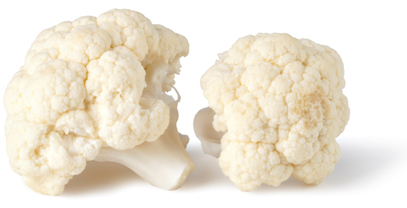 How DIM Destroys Tumors
How DIM Destroys Tumors
DIM targets tumor cells from multiplying and spreading, and it also causes damaging cells to essentially commit suicide. Tests have revealed that breast, prostate, cervical, ovarian, uterine, and colon cancer cells are all targeted by DIM, and in a way that doesn’t harm healthy cells.
Researchers from the University of California, Berkeley, have also found that DIM activates certain cellular stress response pathways in cervical, prostate, and breast cancer cells that make them more susceptible to elimination.
Western Diet Deadly for Prostate Cancer Patients
According to a new study published in Cancer Prevention Research, prostate cancer survivors who consume a typical Western diet (red meat, refined grains, processed foods, and high-fat dairy products) may be at an increased risk of death from returning prostate cancer, as well as other causes.
The Study
A total of 926 men participated in a study conducted by researchers at Harvard T.H. Chan School of Public Health. The men, age 40 to 84, were diagnosed with nonmetastatic prostate cancer. Subjects answered questions about their diets five years after receiving a prostate cancer diagnosis and were monitored for approximately 10 years.
The Results
The men who ate a diet that was more Westernized, were 2.5 times more likely to die of prostate cancer than those who ate the healthiest diet, and 1.5 times more likely to die of any cause.
“Our results suggest that the same dietary recommendations that are made to the general population primarily for the prevention of cardiovascular disease may also decrease the risk of dying from prostate cancer among men initially diagnosed with nonmetastatic disease,” said study leader, Dr. Jorge Chavarro.
Editor’s Note
The researchers say men who have been diagnosed with prostate cancer should regularly consume fruits, vegetables, and fiber and fewer dairy products and less red meat.
Green Tea May Protect Men at High Risk of Prostate Cancer
The American Society of Clinical Oncology recently reported that the active compounds found in green tea could help protect against the development of prostate cancer among men with premalignant lesions.
The Trial
Ninety-seven men with high-grade prostatic intraepithelial neoplasia (an abnormality of prostatic glands believed to precede the development of prostate cancer) and/or atypical small acinar proliferation were given capsules containing green tea catechins or a placebo for one year. Among the 49 men who received tea catechins, five developed prostate cancer in comparison with nine among the 48 in the placebo group—a reduction that was considered nonsignificant. When men who had only high-grade prostatic intraepithelial neoplasia upon enrollment were analyzed, a different picture emerged. Of the 26 men in this group who received green tea catechins, the combined rate of the development of prostate cancer or atypical small acinar proliferation was three, compared to 10 of the 25 men who received a placebo.
Editor’s Note
Tea catechin recipients also experienced a reduction in serum PSA in comparison with the placebo group.
Interesting Fact
About 20 percent of green tea is consumed in Asian countries where prostate cancer death rates are one of the lowest in the world. The risk to develop such malignancy seems to increase among Asian men who leave their original dietary habits after migrating to the United States.
President Jimmy Carter Could Benefit from Proton Therapy
The announcement by former President Jimmy Carter, 90, that he has been diagnosed with melanoma that has spread to the brain and that he will soon start high-dose radiation treatment for the four small cancerous lesions didn't surprise local oncologists on either count. Melanoma metastasis to the brain is not uncommon, according to John Miller, a medical oncologist at Riverside Peninsula Cancer Institute in Williamsburg, VA.
Alan Thornton, a radiation oncologist at Hampton University Proton Therapy Institute, believes that many 90-year-olds (like President Carter) are as energetic, or more so, than some 60-year-olds, and statistically could have a better chance of another decade of life if they receive the right treatment. Thornton therefore believes that President Carter could have a better chance of long-term survival if he were treated with proton therapy.
Dr. Thornton is no stranger to proton therapy. He practiced proton therapy at Mass. General Hospital in Boston and at the Indiana University Health Proton Therapy Institute before moving to Hampton University.
Exactly what treatment President Carter’s doctors are prescribing is not known at this time. We do know he has some excellent physicians on his team.
Judge Tells Aetna to Pay for Proton Therapy
Aetna insurance is one of the larger private insurers that has changed its policy and is refusing coverage for proton therapy for prostate cancer. We hear from lots of newly diagnosed men who desire proton therapy, but are being denied coverage because their insurer, Aetna, no longer reimburses for this treatment. But there may be a ray of light, based on a recent development.
According to PR Newswire, last month, Robert C. Hilliard of Hilliard Munoz Gonzales LLP (HMG), obtained an order from a Newton County (Texas) judge granting a restraining order against Aetna Insurance, preventing the insurance company from denying life-saving cancer treatment for his client, Bobby Allen Bean.
Mr. Bean is suffering from advanced prostate cancer and is being treated at MD Anderson Cancer Center in Houston, Texas. Based upon Mr. Bean’s medical history, his doctors have recommended that he receive proton therapy. They feel other cancer treatments are too risky for Mr. Bean because he also suffers from insulin-dependent Type 2 diabetes. Despite his doctors’ recommendations, his medical insurance carrier, Aetna, has refused to cover the treatment, claiming it is “experimental.”
Mr. Hilliard contends that the judge ruled correctly, “Aetna wants to play God and decided that my client’s life is not worth the expense. It is ridiculous that some person behind a desk at Aetna, without a medical degree or experience in fighting cancer, let alone experience in treating Bobby personally, is allowed to second guess the sound judgment of renowned doctors at the single best cancer center in the world and their patient who is battling an aggressive and deadly form of cancer.”
“What’s more,” says Hilliard, is that “MD Anderson has been using proton radiation therapy for nearly 10 years. This is not some unknown experimental treatment. It works. And my client should be given the opportunity to have the treatment to save his life.”
“Aetna gladly accepted Bobby’s premiums for all of these years and promised him through his policy that they would be there when he needed them. Now, when it’s their turn to fork over some cash to pay for this treatment, they do the math and make excuses.”
The website for the National Association for Proton Therapy (NAPT) notes that “Proton beam therapy is neither experimental nor investigational. It is an established form of treatment that is widely accepted by physicians, government agencies and many insurers, including Medicare and Medicaid (which do not cover investigational or experimental treatments).”
“It’s time that we take a stand against medical insurance companies who ask: ‘How can we save a dollar, instead of how can we save a life?’” said Mr. Hilliard.
About HMG
Hilliard Munoz Gonzales LLP (HMG) specializes in mass torts, personal injury, product liability, commercial and business litigation, and wrongful death.

BOB Comment: We have long been looking for a legal team that might be willing to work with the many men who contact us because they have been denied coverage by their private insurers. HMG may be that law firm. We are exploring this in conjunction with NAPT leadership. Stay tuned.
p="">

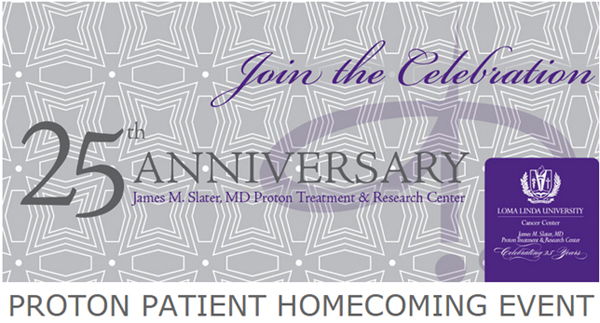
In celebration of LLU Health's 25th Proton Center Anniversary, all BOB members are cordially invited to the James M. Slater, MD Proton Treatment & Research Center Patient Reunion event on Monday, October 26, 2015—just days away!.
Although technology is constantly evolving, LLU Health's commitment to patients and their families remains the same. In fact, when Dr. James Slater came to LLU Health in 1970 to begin a Radiation Oncology Department, his guidance to his staff was simple, “treat patients like they are your own mother and father.” That charge was continued in 1990, when the proton treatment center was opened and it remains their foundation today.
Join LLU Health on October 25-26 for a whole host of activities with the capstone event being the Patient Homecoming Celebration on the 26th. Deb Hickey and Bob Marckini are looking forward to meeting and spending time with many members of the BOB who will be in attendance.
The event is just days away! Sign up today for any of the following events you wish to attend at PROTONS.COM/25years or call 877-LLUMC-4U.
Patient Reunion Dinners: Sunday, October 25 | 5:30 – 8:30 p.m.
We invite you to share a meal and reconnect with fellow proton alumni patients and their families! If you are interested in joining, please sign up here. Enter your name and email address; choose a date range in which you were treated; then check “Patient Reunion Dinners” (and any other activities you are interested in) and click the “Next” button to continue.
Hike the Hills of Loma Linda: Monday, October 26 | 7:30 – 8:30 a.m.
Hike through picturesque hills of Loma Linda which will end in a gorgeous view of the Medical Center and the surrouding community.
Tour the LLU Children's Hospital: Monday, October 26 | 9:00 – 10:00 a.m.
Loma Linda’s Children’s Hospital is growing more and more every day and still remains the leader in pediatric care in the region. Come see how they have expanded their care and are changing lives.
Healthy Relationships Seminar: Monday, October 26 | 10:00 – 11:00 a.m.
Addressing how cancer may be impacting us as well as our relationships is an important topic. Gabriela Gutierrez, MS, MFTI will speak about steps you can take to redefine healthy relationships while acknowledging the unique relational challenges cancer often presents.
Cancer-fighting Foods Demonstration: Monday, October 26 | 11:45 a.m. – 12:45 p.m.
Learn and taste! LLU Health's knowledgeable chefs and dietitians will show how to prepare foods that help to reduce cancer risk, heart disease, inflammation, and more.
Proton Documentary Screening: Monday, October 26 | 1:00 – 1:30 p.m.
Watch an amazing documentary about proton patient alumni and BOB member Pat Purcell and his journey with prostate cancer, protons, and a spring triathlon.
Proton History Wall Unveiling & Mixer: Monday, October 26 | 3:00 – 4:30 p.m.
See the unveiling of LLU Health's new proton history wall and learn their plans for the renovation of the patient wait areas at the proton treatment center.
Proton Homecoming Event: Monday, October 26 | 4:45 – 6:00 p.m.
Join LLU Health staff, friends, patients, and alumni as they celebrate 25 years of the healing power of protons! The event will begin with light hors d’oeuvres at 4:30 p.m.
Sign up now or call 877-LLUMC-4U.

.jpg) Rode 15 Miles Up a Mountain after Proton Treatment
Rode 15 Miles Up a Mountain after Proton Treatment
BOB member, Alan Holt, was treated with proton therapy for his prostate cancer at Loma Linda Health in early 2013. Alan, his wife, Shelly, and 17 members of his family (!), rode the 15-mile Hiawatha Mountain Bike Trail in Northern Idaho this summer after completing his 28-month proton treatment follow-up exam.
“I’m very happy,” Alan told us. “My PSA is dropping steadily and we are so grateful for proton therapy.” When Alan was diagnosed back in 2012, he told us he was “devastated.” He spent the next nine months investigating treatment options. During that time he came across Bob Marckini’s book, “You Can Beat Prostate Cancer: And You Don’t Need Surgery To Do It” and “a light went on.” Alan told us, “When I was done reading, I knew the course of action I would take.” The rest, as they say, is history.
Today Alan is very active—working, biking, and enjoying life. Congratulations on making it to the top, Alan and Shelly!
 BOB Member Responds to Last Month’s Newsletter
BOB Member Responds to Last Month’s Newsletter
Don Giffels commented on last month’s article about Ron Nelson. He said in an email to us:
Great rebuttal to the WSJ article! I had salvage radiation in 2006, after a recurrence of prostate cancer following a radical prostatectomy in 2003. My proton treatment at Loma Linda Health saved my life and I have had no side effects. My current PSA is 0.5, and I am now one month from my 80th birthday. Three cheers for LLUH, Bob, Deb, and the BOB!
BOB Member Turns 102
We spoke with Charlie Einsiedler this month, knowing he had a birthday on September 29. When we asked his age, he said, “102 … I think. I was born in 1913.” Charlie is living in Maine in an assisted living facility with his wife, Betty. They wanted to be near their two sons who are approaching 70 years old, and their daughter who lives in Vermont.
When Charlie was diagnosed with prostate cancer at age 87, his doctors tried to discourage him from having any treatment, believing he didn’t have that many more years to live. “We’ll just give you some hormones,” they said, “and if you’re lucky, maybe you’ll get another eight or 10 years.” “Nothing doing,” Charlie said. He chose proton therapy at Loma Linda Cancer Center, and 15 years later, he’s still going strong, feeling good, and enjoying life to the fullest.
How does a 102-year-old spend his time?
“I do a lot of walking and a lot of reading,” Charlie told us. “I love the monthly BOB Tales newsletter. I look forward to it with great anticipation every month and read it cover to cover as soon as it arrives.” Charlie also continues working on his pet project, a redesign of the internal combustion engine. An engineer by education, he is “greatly troubled” by the 70 percent energy loss with today’s designs. “I have many ideas for recovering that lost energy,” he says.

BOB Comment: God bless you, Charlie, and happy birthday! We wish you and Betty many more years of happiness and good health. We also look forward to reading about your new engine design some day in Popular Mechanics.
If you want to send Charlie a birthday message, you can email him at [email protected]. If you want to send him a birthday card, contact Deb Hickey at [email protected] for his address.
Did you know we have about 150 members who, like Charlie Einsiedler, were older than 80 when treated? And did you know we have almost 230 members who were younger than 50 when treated with protons, including 44 members who were 45 or younger, and even three who were in their 30s? As you can see, proton works for men of all ages.


Where Your Money Goes
A lot of our members ask where exactly their money goes when they make a contribution to proton research at Loma Linda University Cancer Center. Many think it goes directly to help others who have been diagnosed with prostate cancer and they are right. What many do not know, however, is that their contributions are also used to further proton therapy research in general, helping patients suffering from other types of conditions including breast cancer, lung cancer, acoustic neuroma, chondromas and chondrosarcomas, meningiomas, arteriovernous malformations, isolated brain metastases, pituitary ademas, uveal melanomas, nasopharynx, oropharynx, sarcoma of the paranasal sinuses, parameningeal rhabdomyosarcomas, and several pediatric conditions.
Following is a story about two women who were treated with proton therapy for breast cancer.
Studies of proton radiotherapy following lumpectomy for early-stage breast cancer have been ongoing for several years at the James M. Slater, MD, Proton Treatment & Research Center. In these studies, physicians give protons in a short, two-week course rather than in the longer period (generally six weeks) required for conventional X-rays. Published results show that the treatment is highly effective, both in controlling the disease and minimizing side effects by sparing a great deal of normal tissue.
Vicky Ramirez
 Vicky Ramirez of Redlands, California, works at the Breast Health Center at Loma Linda University Cancer Center (LLUCC). She relates, “I had worked there six months when I was diagnosed. I was the initial contact for women coming into the center; now I was one of them.” Even though Ms. Ramirez works in the field and is familiar with the disease, it was devastating when her doctor gave her the news. “It was December 22, 2005, at 9:45 a.m. I even know what I was wearing,” she says. Diligent self-examination led to an early diagnosis, identifying a disease treatable with lumpectomy and proton therapy. “I didn’t need chemotherapy and I had no ill effects from the treatment, so I was very lucky.”
Vicky Ramirez of Redlands, California, works at the Breast Health Center at Loma Linda University Cancer Center (LLUCC). She relates, “I had worked there six months when I was diagnosed. I was the initial contact for women coming into the center; now I was one of them.” Even though Ms. Ramirez works in the field and is familiar with the disease, it was devastating when her doctor gave her the news. “It was December 22, 2005, at 9:45 a.m. I even know what I was wearing,” she says. Diligent self-examination led to an early diagnosis, identifying a disease treatable with lumpectomy and proton therapy. “I didn’t need chemotherapy and I had no ill effects from the treatment, so I was very lucky.”
Ms. Ramirez was one of the 50 women in the first LLUCC trial who received proton treatment. She had no side effects and has been free of cancer since completing her treatments in April 2005. “I’m doing very well,” she says. Dr. David A. Bush, of the department of radiation medicine, was her radiation oncologist. Commenting on the trial, Dr. Bush said, “The recurrence rates are low and the survival rates have been excellent. But most important, we found that the side effect profile was very good.”
The ability to spare so much tissue and thus reduce side effects was especially important in Ms. Ramirez’s case. One potential side effect of X-ray treatment is heart attacks later in life because some of the radiation dose reaches the heart. Ms. Ramirez’s cardiologist feared that standard radiation would affect her heart valve transplant. But proton beams are different from the X-rays most people are familiar with. Protons are particles that can be stopped within the boundaries at the designated tumor volume.
Ann Hughes
Ann Hughes, a professional hair stylist who also lives in Redlands, testifies to her satisfaction with the Loma Linda experience. In 2006, Mrs. Hughes’s annual mammogram revealed that a mass, which had been biopsied a year earlier and found not to be cancer, looked suspicious. A second biopsy revealed cancer cells. Her first reaction, as with most people, was fear and uncertainty. She shared her news with some of her customers. One asked her, “Have you thought of protons?”
“Up to then, I’d never heard of proton therapy,” Mrs. Hughes said. “But I called LLUCC and eventually was connected with Dr. Bush’s nurse coordinator, who was just wonderful: She spent a lot of quality time with me in discussing the proton breast study; she then asked me if I would like to participate.”
Mrs. Hughes was referred first to Dr. Carlos Garberoglio, who performed the lumpectomy and axillary dissection. The operative specimen revealed a small, slow-growing breast cancer, and her axillary nodes did not contain tumor cells. She was then referred to Dr. Bush. “He was very thorough, very professional and very reassuring,” she said.
When asked to describe her experience, Mrs. Hughes remarked that it was easy. “The hardest part for me was getting fitted for the immobilization form, which they called the pod; I had to stay still for about 45 minutes while it was shaped to fit me.” Dr. Bush amplified: “We fit each patient with a treatment brassiere,” he said. “Patients are placed prone in a cylindrical shell with the upper and lower body being supported and immobilized with foam bead cushions. We immobilize the upper chest and breast areas with expandable foam. It takes a while to make this form, but once it’s made, it’s comfortable for the patient even though it immobilizes her.”
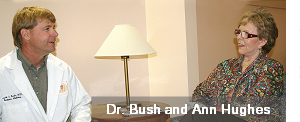 Mrs. Hughes agreed. “Once that form was made, I had clear sailing. I came in every day for two weeks, was there for about a half-hour each time, then went home or to work. The actual treatment probably took only a few seconds.”
Mrs. Hughes agreed. “Once that form was made, I had clear sailing. I came in every day for two weeks, was there for about a half-hour each time, then went home or to work. The actual treatment probably took only a few seconds.”
Summarizing her experience, Mrs. Hughes remarked, “Everyone was just wonderful: very professional, yet very warm. I liked the Christ-centered environment.” The staff, she said, “offered prayer before surgery, but nobody pushed religion. It was a pleasant experience in an awful situation. People care here, which is so important when a person is so vulnerable.”
Please Support Proton Research
Make a Future Gift:
Contact Todd Mekelburg at the Office of Planned Giving at Loma Linda University Health at 909-558-4553 or email [email protected].
Donate to the Marckini Chair:
- Send a check made out to “LLUCC Proton” to Loma Linda University Health, Office of Philanthropy, P.O. Box 2000, Loma Linda, CA 92354. Memo line: “Marckini Chair.”
- Donate online or call Elvia DeHaro at 909-558-5010.
Other Ways to Give:
Contact Matt Miller at the Office of Philanthropy at Loma Linda University Health at 909-558-3284 or email [email protected].

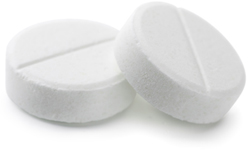 An Aspirin a Day Keeps the Doctor Away
An Aspirin a Day Keeps the Doctor Away
People used salicylate-rich plants to ease pain back in 1550. Fast-forward 3,500 years. That same plant-based ingredient is in aspirin and is still making news.
A study reported on ShareCare.com showed that for people 50 to 65, a dose of 75-325 mg of aspirin a day for 10 years offers many impressive benefits including reduction in bowel cancers by 35 percent, esophageal and stomach cancers by 30 percent, and prostate cancer by 10 percent. It also lowered the number of deaths from those cancers from 35 to 50 percent. Larger doses are less important than length of time the aspirin is taken.
The Downside
Taking aspirin daily can increase the risk of digestive tract bleeds, but this is rare.
You should always talk with your doctor before taking daily aspirin. The article’s authors, Michael Roizen, MD and Mehmet Oz, MD, also recommend that you take a half glass of warm water before and after taking aspirin. This helps keep tablets away from your stomach lining and also helps dissolve the aspirin quickly.
Nine Healthy Snacks That Increase Your Energy
Almonds: Almonds, or really any kind of nuts, are an amazing source of healthy fats and proteins that balance blood sugar levels, which tend to drop if you don’t eat for a while.
Oranges: The vitamin C in an orange helps circulate oxygen throughout your body and into your brain giving you a surge of energy.
Blueberries: Blueberries are filled with antioxidants and they help our neural pathways function more smoothly.
Dates: Dates are 80 percent sugar, but they are whole foods and the sugar in dates is different than processed sugar—you won’t feel a spike in glucose levels, nor will you “crash” later on. Dates are filled with fiber, so energy from dates is effective and long-lasting.
Avocados: Avocados are rich in monounsaturated fats used for energy instead of being stored as unhealthy fats. Avocados also contain B vitamins and potassium, which naturally increases energy levels.
Watermelon: Watermelon is a rich source of vitamins B6 and B1, and minerals like magnesium and potassium, which are natural energy boosters.
Broccoli: Broccoli is high in vitamin C, fiber, iron, beta-carotene, antioxidants and chromium. Chromium helps regulate blood sugar.
Quinoa: Quinoa is full of protein, contains all nine essential amino acids, and provides hundreds of milligrams of magnesium per serving. A healthy carb, it boosts serotonin levels, making you feel happier and more energized.
 Beans: Beans have high levels of protein and they contain the “good” kind of fat. Beans have a low glycemic index, which stabilizes energy levels. Eating just one serving per day can make you feel much less sluggish.
Beans: Beans have high levels of protein and they contain the “good” kind of fat. Beans have a low glycemic index, which stabilizes energy levels. Eating just one serving per day can make you feel much less sluggish.
Belly Fat Worse for Well-being in Older Men
When men think about health problems that can affect their lives as they age, most think about heart issues, prostate problems, or low testosterone. One study points out it’s actually a spare tire that gives men the most trouble.
Researchers from Odense University Hospital in Denmark polled nearly 600 men between the ages of 60-74, using a questionnaire that asked about quality of life factors (physical ability, vitality, and social and emotional health). Researchers also measured the men’s body composition and testosterone levels.
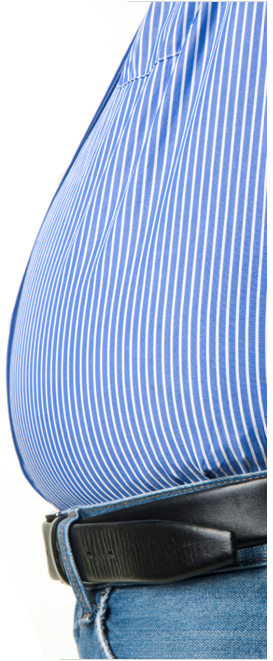 Study Findings
Study Findings
The study found that a big belly had the largest impact on the men’s overall health, and that as their waistlines grew, their quality of life and sense of well-being plummeted. By comparison, low testosterone had little effect on the men’s lives.
The Harmful Effects of Belly Fat
As you may know, low testosterone can impact your bone and muscle mass, to sex drive and hair loss. At the same time, men are more likely to feel the harmful health effects of obesity. Those health risks include:
- High blood pressure
- High LDL (“bad”) cholesterol
- Low HDL (“good”) cholesterol
- Heart disease
- Diabetes
- Stroke
- Cancer
Protect Your Health, Begin Today
Slimming down is one of the most important things you can do to protect your health and well-being as you get older. As a bonus, losing weight may even raise your testosterone levels.
If your daily activities are more sedentary and you’ve noticed your belly growing, there’s no better time than now to start moving. Some studies even show that adding more exercise to your day can help fight cancer. Plus, your heart benefits from exercise, too.
Finally, watch what you eat! The next article may help you get a good start.
Nine Healthy Foods That Help Fight Belly Fat
Black Beans: All legumes are full of protein and fiber—two appetite suppressants. And because of their dark color, black beans are also one of the highest in flavonoids of all the beans. Research shows that flavonoids may prevent the storage of excess tummy fat.
Popcorn: Without the butter and salt, popcorn helps to reduce belly size. Why? It’s a whole grain. One study suggests that people who eat a lot of whole grains had smaller mid sections compared with those who eat mostly refined grains. So while you’re waiting for your popcorn to pop, clear out the white rice, pasta, and bread from your cabinets.
Peanuts: The healthy fats in peanuts are burned more readily than the less-healthy fats in cookies, chips, and other fatty snacks.
Pears: Fresh pears are low in calories and high in fiber. They are also loaded with catechins and flavonols—two antioxidants that are believed to hinder the storage of belly fat.
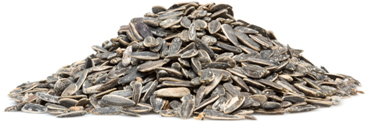 Sunflower Seeds: Unsalted sunflower seeds are high in monounsaturated fat, which inhibits waist widening, according to one study.
Sunflower Seeds: Unsalted sunflower seeds are high in monounsaturated fat, which inhibits waist widening, according to one study.
Cold Potatoes: If you chill potatoes overnight, they form something called resistant starch crystals—a constituent of fiber that triggers the production of two hunger-halting hormones, according to research. Resistant starch helps the body incinerate more fat for fuel while making less fat available to hide away in fat cells.
Safflower Oil: Due to the omega-6 fatty acid (linoleic) in this oil, just a few tablespoons a day may amp up your metabolism.
Tea: Everyone always seems to tout the benefits of green tea, but it seems the white version of this brew may be a veritable fat blaster. When human fat cells were treated with white tea extract in a lab study, the cells absorbed about 70 percent less fat than the untreated cells did. And those same tea compounds also triggered the breakdown of fat in existing cells.
Apple Cider Vinegar: This vinegar has a compound called acetic acid, which turbocharges the body’s ability to burn fat and also hinders fat storage.
Series: Top 20 Most Common Health Questions
Last year, we began a series on the top 20 most common health questions (and answers) from Business Insider Magazine. Here is another question from that list.
Is it safe to microwave food in plastic containers?
Short answer: Yes. But, the plastic container should display the words “microwave safe.” This means that the Food and Drug Administration has tested the container to make sure no chemicals used to make the plastic leak into foods during microwaving. If chemicals do seep out into food, the amounts are tiny and not dangerous to our health. As a general guideline, plastic grocery bags as well as most plastic tubs that hold margarine, yogurt, cream cheese, and condiments are not microwave safe.

Bob Marckini’s book, “You Can Beat Prostate Cancer And You Don’t Need Surgery To Do It,” is listed in the No. 3 position on a search for “prostate cancer” on Amazon.com (all departments) out of 45,757 search results at the time of this writing. Within the “books” department, the book is listed in the No. 4 position on a search for “prostate cancer” out of 30,829 search results.
The book has 228 reader reviews on Amazon—more than any other book in the top 50!
Here is an excerpt from what one reader recently had to say:

I strongly recommend reading this book. By John Giangardella
If you have a rising PSA or you have had a biopsy that shows cancer, I strongly recommend reading this book. Once you are over the initial shock, the next step is learning what to do about it. The author has detailed the options available including the pros and cons of each treatment. There is help available and you have choices. I have recommended this book to all my friends who have been diagnosed with prostate cancer.
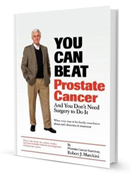 More Information / Where to Buy the Book:
More Information / Where to Buy the Book:
Paperback: $19.00--•--Kindle: $9.99--•--NOOK Book: $9.99--•--Apple iBook: $9.99
Proceeds from book sales help fund BOB efforts and support proton therapy research.
Ask about our bulk discount for paperback books: [email protected].
If you found Bob’s book helpful in making your proton treatment decision, PLEASE POST A REVIEW on Amazon. Once you are logged into your Amazon account, click here and click the “Write a review” button. Don’t forget to rate the book from 1 to 5 stars!

 Reader Feedback
Reader Feedback
Last month we wrote about young Jennifer Gardner, who had been diagnosed with an inoperable brain tumor about 20 years ago. Jen is on our newsletter distribution list, and when she saw her story, she was thrilled. She wrote back to tell us she continues to work in the emergency department at Loma Linda University Cancer Center and has just qualified for flight medic.
In the photo is flight medic Jennifer Gardner in training. An inoperable brain tumor didn’t stop her from pursuing her dream!
When to Throw Away Common Household Items
Here are some tips on when to dispose of common household items from nurse and author, Michelle Katz, LPN, from her book, “Healthcare Made Easy:”
| Item |
When to Replace |
| Contact Lens Solution |
Three months after you break the safety seal. Germs can infiltrate lens solution, increasing chances of eye infections. |
| Cutting Boards |
Rarely. But wash them each time you cut raw meat, poultry or seafood. Use detergent and hot water. Rinse and immerse in a solution of 1 part white vinegar to 4 parts water. Rinse again and pat clean with paper towels. |
| Sponges |
Two weeks. Sponges can harbor bacteria. To sanitize, clean them in dishwasher or heat wet sponges in the microwave for 1 minute. |
| Pillows |
Once a year. Pillows collect hair, skin and dust mites. |
| Prescription Drugs |
As they expire. After their expiration date, they can oxidize and degrade into chemicals with very different and sometimes dangerous side effects. Some expired antibiotics may even cause serious kidney or liver damage. |
| Vitamins |
Every Two years. Vitamins usually lose their potency after two years. They won’t be harmful, just less effective. Nutritional supplements are usually good for about three years if stored in a cool, dry, place. |
| Fire Extinguishers |
Every 10 years. They can lose pressure over time. Check the gauge monthly. Many local fire departments will inspect extinguishers for free. |
| Toothbrushes |
Every three to four months. They tend to lose their effectiveness and don’t clean as well after that period. You may also want to toss your toothbrush after the flu or strep throat. Soaking it in mouthwash or hydrogen peroxide can disinfect your toothbrush according to the Univ. of Texas Medical Branch. |
| Running Shoes |
Every 500 miles. Or replace when you see wrinkles in the foam between the soles and tops, or when heals wear down. |
Estate Planning Hints
BOB Member Ron Hendricks is Director of Gift Planning for Trinity Western University. He regularly copies us on his “News from Ron” mailings, which are helpful hints on estate planning to the readers of his newsletters. We have found Ron’s newsletters and suggestions to be timely and beneficial. With his permission we periodically share some of his wisdom with our membership. This segment is called “Passing Unequal Shares in Your Will.”
Passing Unequal Shares in Your Will
Because children often look at an inheritance as a representation of their parent’s love, most parents leave children equal shares of their estate. However, there are a number of good reasons why a parent might leave unequal shares. These reasons consider the special needs of some children, the potential large financial success of one child, a benefit previously given to a child that will be balanced in the estate, estrangement from a child, or a blended family.
You will want to discuss carefully these circumstances with your attorney and advisers. After prayerfully thinking through your situation, you may decide that there are good reasons for making an unequal distribution of property to children. While the reasons are apparent to the parent, they may not always be as easily understood by the children.
Many parents choose to explain and disclose an “unequal shares” plan during their life. If you as a parent are thinking about passing an unequal amount to children it would be wise to have a family meeting either at your home or at the office of a trusted adviser. Children could then have the ability to discuss and understand the plan with the parents and ask questions of the adviser.
Did You Know?
There are 196 countries in the world today. Three of them—Liberia, Myanmar, and the United States—are the only ones that do not use the metric system.
The system we use in the U.S. is really a hodgepodge of various units that often seem to have no logical relationship to one another: Twelve inches in a foot, three feet in a yard, and 1,760 yards in a mile. Water freezes at 32° F and boils at 121° F, etc.
The rest of the world uses the metric system, where all you need to do is multiply or divide by some factor of ten: 10 millimeters in a centimeter; 100 centimeters in a meter, 1,000 meters in a kilometer; water freezes at 0° C and boils at 100° C, etc. The metric system makes a lot of sense, don’t you think?
Great Quotes
Every month, for years, we have included a “Quote of the Month” right before our Final Thought section. We thought about removing the quote altogether considering we also include a quote at the beginning of each newsletter. Instead, we decided to move it to our Odds and Ends section. You see, Bob Marckini and Deb Hickey receive quotes from members and friends almost every day. They are usually inspirational, thought-provoking, or just plain funny, so we like to share them with our readers.
If you have a quote that you’d like to see in an upcoming newsletter, send it to [email protected]. If you’d like, send a reason for why you like it, and let us know if we can mention you by name as the person who submitted the quote. Please note: We receive dozens of quotes each month and cannot reprint all of them.
This month’s “Great Quote” was sent to Bob by one of our members.
‘Age is not important unless you’re a cheese.’ —Helen Hayes

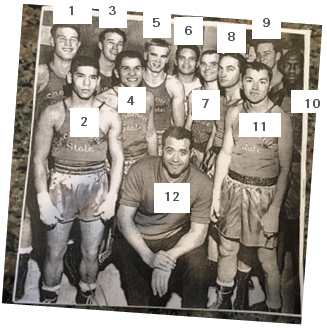 Last Month's Brain Teaser
Last Month's Brain Teaser
The photo on the right was taken in 1959 at Sacramento State College. One of the individuals in the photo is known by most of us.
Can you identify which one it is and give us his name?
Hints: 1) If you were treated at LLU Health, you have a better chance of getting the correct answer; and 2) if you’ve seen him play golf you would agree with us—he should stick to boxing!
Answer: Dr. Lynn Martell, number seven. This is the Sacramento State Boxing Team. Dr. Martell, currently DMin, Director of Special Services at LLUH, was then a golden glove champion boxer. The college is now named California State University at Sacramento.
Incidentally, that team was inducted into the college boxing hall of fame.
Winner: The person to write in first with the correct answer was Tony Dente of Bendestorf, Niedersachsen, Germany. Tony is a third time brain teaser winner! When we alerted Tony that he had won again, he responded:
The real winners are all who have been associated with protons—the pioneers at Loma Linda, Dr. Martell, and Bob Marckini.
He added:
I am very fortunate to have been blessed with five more grandchildren since my proton treatment, making a total of eight.
Tony recently bought a second home in South Carolina—“a really neat house on the water on Dataw Island in South Carolina.” He hopes to have Bob and Lynn visit him and give a little “proton pep talk” to some friends in the community and play a few rounds on two fabulous golf courses nearby. Perhaps Lynn’s game will be improved by then …?
Congratulations on your third win, Tony! A signed copy of Bob’s book is on the way …
New Brain Teaser
What do all these countries have in common?
| Canada | Czech Republic | China | England |
| France | Germany | Italy | Japan |
| Poland | Russia | South Africa | South Korea |
| Sweden | Switzerland | Taiwan | USA |
Answer next month: Send your brain teaser answers to [email protected].
Testosterone (tes-tos’-te rone)
Noun: A hormone that makes it impossible for men to cry, enjoy figure skating, or buy the right duvet cover.
Sweet Revenge
A man takes his place in the theater, but his seat is too far from the stage.
He whispers to the usher, “This is a mystery and I have to watch a mystery close up. Get me a better seat and I’ll give you a handsome tip.”
The usher moves him into the second row, and the man hands the usher a quarter.
The usher looks at the quarter, leans over and whispers, “The wife did it.”
Senior Citizen Pick-up Line
An elderly widower walks into an upscale cocktail lounge. He is in his mid-eighties, very well dressed, hair well groomed, great looking suit, flower in his lapel, and smelling slightly of an expensive after shave. He presents a very nice image.
Seated at the bar is a classy looking lady in her mid-seventies.
The sharp old gentleman walks over and sits alongside her. He orders a drink and takes a sip. He slowly turns to the lady and says,
“So tell me … do I come here often?”

How Far You Go In Life Depends On You Being …
- Tender with the young,
- Compassionate with the aged,
- Sympathetic with the striving, and
- Tolerant of the weak and strong.
Because someday in your life you will have been all of these.
—George Washington Carver
Low PSAs to all,
Bob Marckini and Deb Hickey
To print the BOB Tales newsletter or view the newsletter with a larger font size, click here for the PDF file.
NO MEDICAL ADVICE: Material appearing here represents opinions offered by non-medically-trained laypersons. Comments shown here should NEVER be interpreted as specific medical advice and must be used only as background information when consulting with a qualified medical professional.
